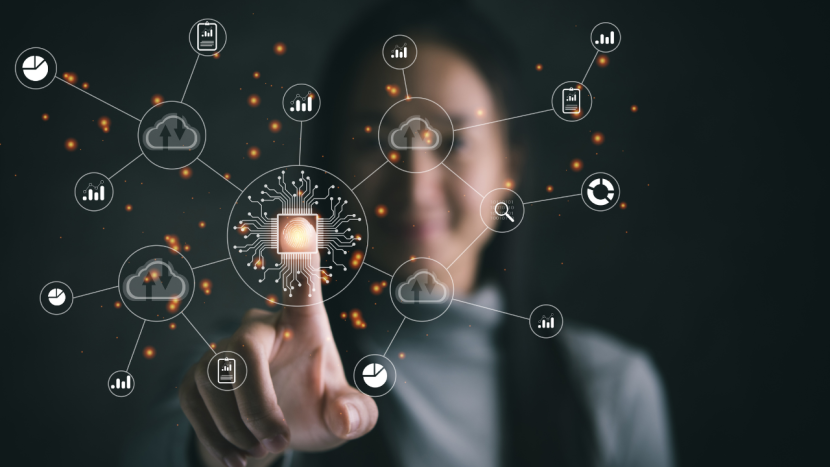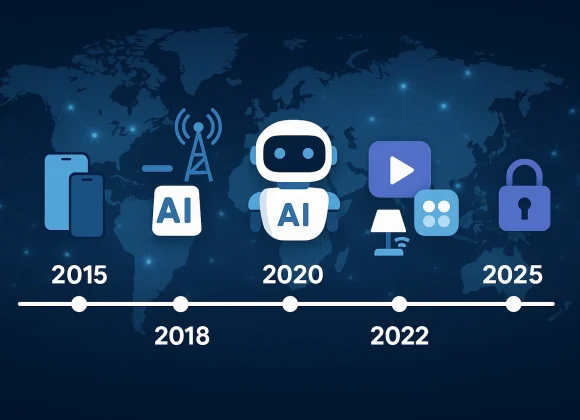The Internet of Things (IoT) connects physical objects—like vehicles, appliances, and devices—through embedded sensors, software, and connectivity. These systems autonomously collect, share, and analyze data without human intervention.
IoT spans smart home gadgets, wearables, industrial machinery, and city infrastructure. These interconnected devices communicate via the internet, improving sectors like agriculture, traffic control, factory automation, and supply chain logistics.
In an enterprise context, IoT helps to monitor temperature, energy use, and machine health, automate business processes, and guide more informed decision-making in an increasingly connected world.
How Does IoT Work?
IoT devices use sensors to detect real-time environmental changes like temperature, humidity, or motion. These sensors are built into multi-purpose gadgets, such as smartphones with GPS, cameras, or biometric scanners.
For exchanging data, there is a need for connectivity. Wireless tech like Bluetooth, Wi-Fi, or cellular networks can facilitate data transmission depending on bandwidth, distance, and power management.
When data is in the cloud, processing and analysis take place to produce insights and activate actions. It may vary from the control of a thermostat to avoiding a car accident.
Lastly, user interfaces let people interact with IoT systems via apps or devices, ensuring intuitive control and better experiences.
Example of IoT applications
Healthcare: In the healthcare industry, IoT sensors observe patients remotely and monitor vital signs such as blood pressure and heart rate. They can detect conditions early. IoT also assists with tracking medical gear, inventory control, and taking medication.
Manufacturing: IoT devices observe machine activity, predict failure, and refine production. Thermometers and humidistats follow temperature and moisture levels to optimize conditions for temperature-sensitive products. IoT also aids in inventory tracking, supply chain management, and product quality control.
Retail: IoT sensors monitor customer activity, inventory, and store layout optimization. Sensors detect foot traffic and product placement for enhanced customer satisfaction and inventory levels.
Agriculture: IoT sensors monitor the soil, climate, and vegetation. Sensors regulate irrigation and monitor livestock health. Low-power or solar-powered devices can operate independently in remote regions.
Transportation: IoT devices maximize vehicle performance, routes, and cargo tracking. Sensors monitor fuel efficiency and ensure cargo delivery in the best condition, enhancing sustainability.
7 benefits of IoT
The Internet of Things (IoT) is expanding due to business, even if people use a lot of gadgets at home. A company can benefit greatly from IoT devices, so let’s examine some of the main benefits that these smart gadgets offer.
1. Cost Savings
IoT devices cut operational costs through energy automation (smart lighting) and predictive maintenance to avoid equipment failures. AI-powered sensors in factories optimize heating systems, lowering energy bills. IoT streamlines logistics with optimized delivery routes, reducing fuel use and downtime.
2. Improved Data Collection
Interconnected sensors gather real-time data on customer behavior, supply chains, and worker performance. Stores replace manual customer tracking with IoT sensors to analyze traffic and purchasing patterns.
3. Increased Automation
Industrial IoT (IIoT) automates repetitive tasks like machine temperature monitoring, freeing employees for strategic roles. Intelligent devices monitor production lines, letting technicians focus on innovation over maintenance.
4. Operational Efficiency
IoT boosts efficiency via real-time monitoring. Tire pressure sensors alert drivers to underinflation; route optimization software reduces fuel use. Predictive maintenance tools track equipment wear, scheduling repairs pre-failure to ensure seamless operations.
5. Improved Safety
IoT protects workers by tracking dangerous settings. Sensors identify overheated equipment, which leads to shutdowns to avoid accidents. Wearables monitor employees’ vital signs in hazardous settings to minimize health threats.
6. Remote Monitoring
IoT devices monitor dangerous equipment (e.g., high-pressure systems) remotely, protecting workers. IoT tracks air quality or traffic in cities, enhancing public services. Real-time data collection enables better decision-making without sacrificing safety.
7. Customer Experience
IoT makes interactions more personal, such as delivering immediate coupons to customers based on in-store activity. Companies study customer tastes to customize services, enhancing satisfaction and loyalty through data-based decisions.
Challenges of IoT
- Security Threats: IoT devices are at risk of cyberattacks and data breaches that could compromise sensitive data. Robust cybersecurity practices are necessary to avoid these risks.
- Incompatibility: Devices from various vendors might employ different protocols, thereby complicating integration. Standardization initiatives must be undertaken to enable effortless communication.
- High cost: Installation of IoT systems involves a high cost of investment in infrastructure, devices, and security, which proves to be a hindrance for small enterprises.
The Future of IoT
The Internet of Things isn’t just growing—it’s evolving in ways that will fundamentally change how businesses operate. Imagine factories that predict maintenance needs before breakdowns happen, retail stores that adjust lighting and temperature based on customer flow, and supply chains that optimize themselves in real-time. This isn’t science fiction – it’s the very near future of IoT.
Here’s what’s coming:
Growth & Expansion – we’re not just talking smart thermostats anymore. Entire cities, factories, and supply chains are getting wired up, creating networks that make today’s IoT look simple.
Edge Computing – Instead of sending everything to the cloud, devices are getting smarter. Your warehouse sensors won’t just collect data – they’ll analyze it on the spot and make instant decisions.
AI & Machine Learning – The next generation of IoT won’t just collect data – it will interpret patterns, predict outcomes, and suggest actions in plain language that humans can understand.
Blockchain for Security – With blockchain and other technologies, future IoT systems will have protection baked right in—like a digital immune system for your entire operation.
Sustainability – The IoT revolution is going green, helping businesses track and reduce their environmental impact automatically.
The most successful companies won’t just use these technologies; they’ll rethink their entire operations around them. The question isn’t whether to adopt IoT, but how quickly you can make it work for your business. One thing’s certain: the businesses that figure this out first will leave their competitors playing catch-up.




